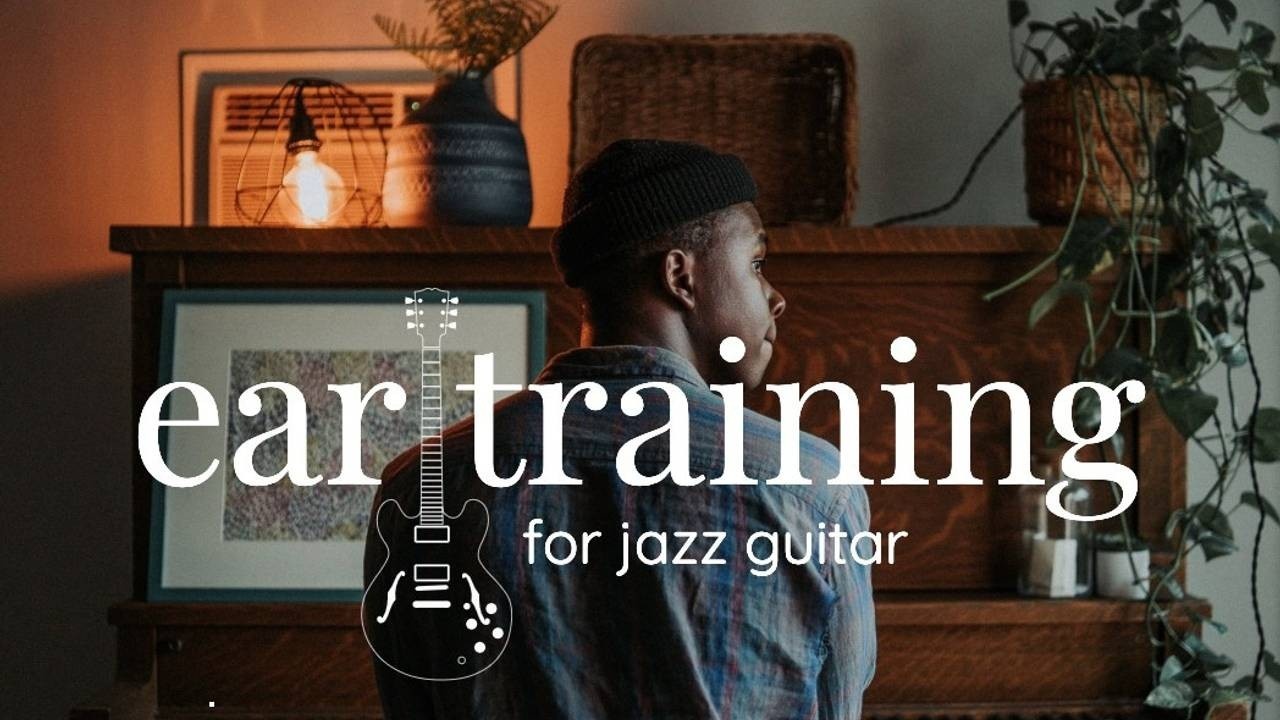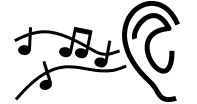
Jazz Ear Training
Nov 23, 2020Steady Musical Growth and "jazz performance ear training"

Perhaps the most overlooked aspect of learning to make music is the training of the ears. Ear training. Working on (and achieving) good listening / hearing is seldom discussed... but make no mistake: musicians who actually train their ears usually make great strides in a short amount of time! Ear training anyone...?! Let's follow uncle Pat's advice. :-)
Why develop our ears?
We know that changing our general perception (of life, music, relationships, etc.) can change the way we create and play music. Basically: growing as a human being will affect many aspects of our lives. Of course, changing and developing our aural perception should also yield results, musically speaking.
In fact, I can almost guarantee that exercising your hearing a little will improve your playing (regardless of level, instrument or style). In fact, let's go further: I GUARANTEE it! But you have to do it "well" and be open to suggestions.
And, yes, it's that simple! Work on the ears, and you'll be a better player.
If you were only allowed to practice and work on one musical topic throughout your life, only ear training (and developing deeper listening in general) would provide you with steady musical growth for the duration. You can only go so far practicing techniques, scales, harmony (etc.)
All the jazz legends tell us the same thing: It's all about listening! Great music is performed when good musicians play together and closely listen to each other. In short, the better you hear yourself and other musicians around you, the greater your musical abilities become (to play, interact, improvise, compose, etc.). Sounds empowering, doesn't it?
Ear Training Overview

I don't like the expression "ear training" in general because it's too often associated with classes, books or software. These tools can certainly help... but they can sometimes feel out of context (compared to the playing situations musicians experience). Recognizing intervals in a classroom is very different from listening to sounds "under fire," on stage!
This article concerns the general aspects of listening and aural perception while playing music. This is NOT what you would expect from a classical ear training class in college. Several guidelines will be given to put the concepts into practice. Most of the tips and techniques are directly related to jazz performance.
If this is not what you're looking for: There are plenty of ear training resources out there to help you work on technical ear training. I won't go into more details here. For some concrete, simple (yet effective) exercises and suggestions, here's a link to a great ear training article / software (FREE) that is more "technical" (interval recognition, chords, progressions, etc.)
Ear Training in performance: jazz musicians on the bandstand

Please imagine the following as if it were really happening to you, today: You get a call from someone asking you to sub in and play on a gig tonight, only a few hours from now. Your bandmates are strangers from out of town (good jazz musicians, the Doxas brothers above). It's understood that the band will only be playing tunes you're familiar with. Pay is good, you accept.
By the way: there's a crowd of 20-30 people waiting in that jazz club. The audience is eager to hear the band. People are also curious: there's a "new guy" in the group tonight. That's you! Ready? You meet up, plug in, tune up, discuss the set list (standards) and... Show STARTS!
So, let me ask you a few questions. Please be honest with yourself. In that unexpected musical situation, could you ...
- Identify the chord substitutions imposed by the pianist? (provided you do know and hear the "normal" changes)
- Determine what meter the drummer decided to shift to?
- Hear if anyone (yourself) is lost in the form?
- Sense if the music is rushing or dragging?
- Wing it and improvise a decent solo on an unfamiliar 32-bar form tune? (playing mostly by ear, "faking it")
- Tell if someone is out of tune in the group?
- Hear if the sounds are well balanced? (are the drums too loud? is the bass too soft? etc.)
- Get the "musical cues" as to how the other musicians will be ending the current tune? (vamp, turnaround, tag, other?)
- Tell right away what inversion of the chord the bassist is implying?
- Interact on a melodic, harmonic or rhythmic level with any other band members? (While you soloing or comping)
- Tell when it's time for you to lay out completely? (know when to NOT play)
- etc.
Assessment
So? How did you do?! Was the gig good, barely okay or a total train wreck? The live playing situation is very particular and requires different listening skills from those taught through ear training software, books or CDs. Right?
If you cannot honestly answer "yes" to at least half of the questions above, you know you have some serious work to do in ear training. Don't worry though ... because you've come to the right place to get better! Wherever you stand, only more experience and serious dedicated listening can help you feel and play better in that kind of situation.
Do you now understand the difference between technical ear training exercises and "real life" type of aural perception?
Even if you finish with an "A+" in all ear training classes
at Berklee College, does it mean that you'll be genuinely
listening and interacting with other musicians on stage?

What do you think? In short, "ear training" is not just about recognizing intervals or taking melodic dictations; it's also about listening to yourself and to other musicians while you perform. Always keep that in mind. We have to train our ears in context.
How to do it?
You should work on jazz performance ear training:
1. When you're alone;
2. When playing with other musicians.
Remember: The main goal here is to be better prepared for your next musical engagement (like the fictional situation above). Your main focus should be on applying all of this in real playing situations.
Suggestions and Exercises: By yourself
I like to think of the by-yourself portion of ear training as preparation for the next gig or rehearsal. By being better prepared (mentally and aurally), you can catch a lot of stuff more easily in the heat of the performance.
- ONE: Rhythms -
To me, time/feel and rhythm is the most important glue between the players in the band. Poor rhythm and feel is therefore the #1 mistake made by musicians of all levels and styles. When music falls apart, it's often because it's not grooving / swinging coherently ...
I find that rhythm is the most underrated aspect of ear training. So, I'm going to give you lots of suggestions on this topic. The amount of information is huge, but don't panic. Pick *one item* in the list and work at it for a long time. No one ever mastered all this stuff overnight... here's the scary proof!
Suggestions (with metronome) :
- Play through tunes in 4/4 swing (improvising and comping) with the metronome set as the "2&4" of each bar. See this video......
- Same as above, but use the metronome as the "3" of each bar. See this video......
- Use the metronome as above, but on different beats. (Not just the "3").
- Then, try the "and" of each beat (the 8ths notes that are on upbeats)
- Finally, play through tunes again but set the click of the metronome as being a different part of the 8th note triplet.
While working with the metronome, be aware of your tendencies. It might be that you speed up at certain moments (or do something else you find is not smooth). Write it down and shed it! By taking notes and working on what's difficult for you, you're getting better at hearing yourself and others play different rhythms in musical contexts. Musicians bring "all they have" to the bandstand, including that last practice session!
Remember: The metronome might not groove or swing but it's a good gauge for your time feel. Then turn the metronome off!
Suggestions (WITHOUT metronome):
- Record yourself playing through tunes alone (comping, improvising). Listen back and analyze your time / feel. Be critical but don't judge. Take notes, analyze.
- Do the same thing twice as slow.
- And twice as fast. Stay focused, make music! It's worth it, I promise.
- Improvise playing just one rhythmic figure for many choruses. Notice how the tempo feels. Do you drag? Do you rush? Start with just whole-notes, then half-notes, and quarter-notes, and then 8th-notes, etc.
- Play decent walking bass lines (see this video) on your favorite standards. Play in "bassist" time for a while!
Suggestions (with AND without metronome):
- Time Awareness: read through Peter Erskine's book several times and play the examples.
- Charleston: play this simple figure starting on all downbeats (use a familiar form such as 12 bar blues). See this video...
- Half-Notes: play this simple figure (use a familiar form such as 12 bar blues). See this video...
- Repeat the process starting on all of the upbeats!
- Play on all three 8th-note triplets individually for many choruses. Repeat with quarter-note triplets. Do this with other figures also, Please refer to Ari Hoenig's book.
- Work on different polyrhythms (for instance, playing 4 notes for every bar of 3/4 is a 4:3 polyrhythm). Again, refer to Ari Hoenig's book.
Okay, so that's it for rhythms! Just keep in mind: you should frequently work on a little bit of rhythm / time / feel. Ideally, each time you want to train your ears. :-)
- TWO: Sing what you play -
Sing and Play ... Play and Sing. It doesn't always work well, but focus on it for a few minutes. It's a great exercise. Sometime I wonder if I'm singing what I'm playing... or is it the other way around? Please dismiss teachers saying that this is just "smoke and mirrors". Singing and playing at the same time is an exercise. You don't have to do this on gig! Also see this article on playing "All The Right Notes".
- THREE: Pacing-
While improvising, wait a little longer before you play that next idea. The previous line will ring in your head. Try to connect your next idea with that "echo" of the previous line. Make your solo sound like a conversation (question then answer).
Think about this consciously, make an effort. Some people will even say: "Wait twice and play only on your third impulse." You'll be amazed at how fewer notes actually want to come out! With this in mind, it becomes possible to play less and still convey the same message and energy. This is very important. By waiting, you're giving yourself the chance to really hear what you're playing.
- FOUR: Play Along -
The best ear training there is! Perhaps the most important "non-technical ear training" exercise you can do by yourself: Put on a great album and play along. Close your eyes and imagine that you are in fact jamming with the boys on the recording. Let your intuition guide your best ear training session ever! If you do it a lot, you'll absorb by osmosis.
One other thing I like to do is accompany (aka comp) a recorded solo I know well. It works beautifully for horn solos. Disregard the accompaniment on the album and do the best you can. Comping behind Charlie Parker or John Coltrane can be a tough gig though! Of course, transcribing is always a good idea, but that's not within the scope of this jazz performance ear training article...
Now, let's see how you can apply this type of ear training on the bandstand...
More Suggestions and Exercises: Performing Situation
The other aspect of ear training can (and should) take place in real-time, on the bandstand. Be prepared, and then make a conscious effort to apply the principles when it's showtime! I mean: a gig, a rehearsal or any other real, actual playing situation where you are performing jazz. I suggest you try only one of the following ear training exercises at a time to start! Focus on one concept during a complete song; you'll be amazed at what you can already hear.
-Pacing Your Ideas-
(aka listening to yourself)
Practice this alone at first (see above) and then try it live or at rehearsal. Of course, you'll put less focus on pacing in performance because so much is happening already... Try and make a conscious effort though, wait a little longer before you play that next note! Let the music breath; play less and listen more. I insist: this is very important!
By waiting, you're giving yourself the chance to really hear what you're playing. You're also giving other players (and the audience) a chance to digest what you just said musically. In the silences (between the things you play), pay particular attention to how the other musicians (and audience) react. Adjust accordingly!
-Listening for Roots Movement-
(aka listening to the bassist's ideas)
While improvising, try to follow the bassist's lines. Hear what he's outlining and connect your ideas with that. You're the highest melody, he's the lowest melody. You can get parallel, contrary or oblique motion. This is called counterpoint (only this time, it is spontaneous).
In short: interact on a melodic and rhythmic level with the bassist while improvising and/or comping.
-Listening for the Pulse and its Subdivisions-
(aka listening to the drummer's ideas)
While improvising, listen to how the drummer/percussionist implies the pulse. You can certainly relate musically to what's happening: Can you feel the time and its subdivisions? Can you follow the form? Could you play "air drums" for a while?
Try to connect your ideas with the multiple layers of rhythms. This is less technical and more intuitive, I find. It's often fairly easy to "gel" with a drummer musically speaking; it's just instinct. Prepare yourself by working alone on rhythms and time / feel exercises (with AND without the metronome). See above.
-Listening for Harmony/Chords/Extensions/Resolutions-
(aka listening to pianist/guitarist harmonic ideas)
While improvising, pay particular attention to what the accompanist chooses to outline. Also notice what he's leaving out. Listen for the extensions, their resolutions and the general harmonic flow of the tune. It could be that the harmony is very precise or somewhat vague. Connect your blowing with that; hopefully, the accompanist will also try to follow YOU, the improviser!
In short: interact on a melodic, harmonic and rhythmic level with the accompanist when improvising. See the No nonsense guide to jazz harmony...
- Listening to SOUNDS -
Dynamics - Timbre - Volume - Blend - etc.
This is very general, but you have to try it. Listen for everything that is NOT notes, chords and rhythms during the whole tune. Focus on the different sounds coming from the instruments.
Loud, soft? Round, Square? Low, high? (in pitch) Many sounds, few sounds? (texture, density) Fast, slow? etc.
By doing so, you may find out more about your own role within the group. Maybe you'll find a way to blend in more and add to the group's overall sound and texture. Or maybe... your amp was just way too loud the whole time! Who knows?! (-;
Performance Ear Training Wrap-up
Of course, great musicians can do all of the above simultaneously most of the time (and a bit more). Shocking, isn't it? I believe the trick is to get in the zone and let things flow naturally... all the while keeping your ears wide open. In the end, you'll want to hear everything, all of the time. We all know it's practically impossible but we keep on trying!












